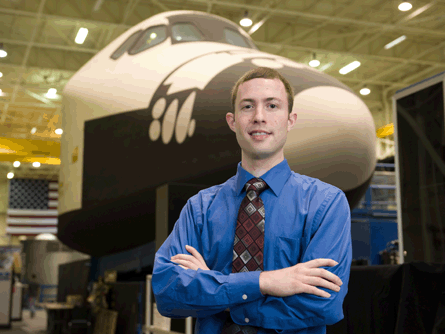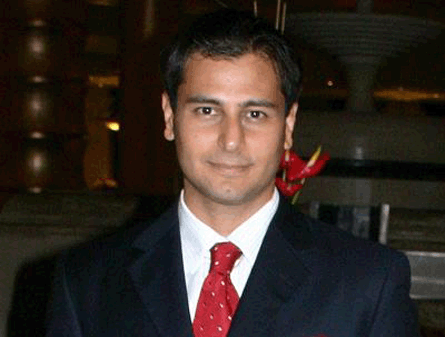Growing up in Dayton, Ohio - home of the Wright brothers - instilled in Mike Grant a fascination with aviation and an ambition to become an astronaut. His experience as a cooperative programme student for NASA throughout his time at university studying advances in flight mechanics has given the 26-year-old a hope of realising that dream.
Grant, named joint-winner in this year's Boeing Engineering Student of the Year - part of the Flightglobal Achievement Awards announced in Dubai last night - is a graduate student at Georgia Institute of Technology's Space Systems Design Laboratory. Coming up with ways in which a spacecraft can descend more gently once it bursts into a planet's atmosphere has been very much the focus of his work.
 |
|---|
After graduating first in his class with a degree in aero engineering at Purdue University, Indiana in 2005, Grant moved to Georgia Tech in Atlanta, where for his Masters research, he developed a new methodology for robotic exploration of Mars using pinpoint landing technology. "This new entry, descent and landing architecture, called Smart Divert, challenges the paradigm of Mars robotic exploration," says his tutor in his entry for the award. In 2007, while working on his masters, Grant participated in NASA's High Mass Martian Landing design competition, winning first place with his team for their design, Heavy MEDL.
Grant hopes to complete his doctorate in 2011, for which he is looking at rapid trajectory optimisation and hypersonic aerodynamics and the way they can be applied to the design of slender, high performance entry vehicles. As he puts it in simple terms: "It's about taking something going very fast and landing it slowly and safely by getting rid of a lot of energy on the way."
Since his time at Purdue, Grant has been a "NASA coop", spending his summers working at many of the agency's facilities, including the Johnson Space Center's flight design and dynamics division in Houston and the Langley Research Center in Virginia. "It has been a great opportunity," he says. "I have worked on Space Shuttle ascent aborts, based on a small island in the Atlantic. After Columbia [which crashed in 2003], I was involved on International Space Station trajectory operations, which was responsible for making sure the ISS doesn't run into other stuff in space - objects or debris."
After his PhD, Grant - who is a private pilot but struggles these days to find time to keep his hours up - is considering applying to the agency to carry out further research. "The whole point of the PhD is to do what's never been done before. I'd quite like to continue that with NASA," he says.
Working for NASA could allow him to achieve his ultimate ambition - to go into space himself. In the early days of NASA, the rigours of space travel meant all astronauts had a military background and were often test pilots, albeit with engineering or scientific skills. Today, although physical fitness and teamwork skills remain key, doctorate-level engineers, geologists and other scientists are equally sought after. "Having a PhD in the right discipline is likely to be among the things they will be looking for," he says.
In his entry for the Engineering Student of the Year award - which was judged by a panel of former senior Boeing engineers - his supervisor, Dr Robert Braun, professor of space technology and director of the Space Systems Design Laboratory, describes Grant as an "extremely intelligent and enterprising young man with tremendous potential".
Braun continues: "Across his research efforts, Michael has demonstrated exceptional initiative, maturity, creativity and dependability. His strengths include a strong understanding of the fundamentals of aerospace engineering, a significant desire to produce results of benefit to society while learning in the process, and a tremendous interest in new research challenges."
For the first time in four years of running the Engineering Student of the Year award in association with Flightglobal, Boeing's judges failed to pick one winner. Sharing the prize with Grant is Can Bayram, a fifth-year PhD student in the Center for Quantum Devices at Chicago's Northwestern University's electrical engineering and computer science department.
Originally from Turkey, he opted to come to Northwestern after graduating with a BS in electrical engineering from Bilkent University in Ankara, because of the reputation of the centre and its director, Manijeh Razeghi, "a world-leading authority" in her field, according to Bayram. "It was a great thing, a big opportunity to get this offer," he says. "But we are expected to work hard. It is very demanding. But the best bit is that from basic science we create an end product that we can show people."
Bayram - who hopes to graduate with his doctorate next year - specialises in the development of high-performance nitride optoelectric devices. His research "continues to make many significant contributions to space technology and innovation", according to Razeghi, who is Walter P Murphy professor at the Center for Quantum Devices.
 |
|---|
Bayram - who was unable to attend the awards ceremony - has published a series of papers and a piece on the world's first demonstration of GaN nanostructured p-i-n photodiodes became the third most downloaded article out of more than 80,000 in Applied Physics Letters.
Applications of his work include ultraviolet detectors offering compact and portable substitutes for photomultiplier- or silicon-based biological agent detectors, and light-emitting diodes which can be used instead of flourescent lights. He has also helped develop environmentally-friendly emitters which can detect and analyse illegal drugs and exlosives at security checks, including at airports.
"All these devices are to be vital for space and aeronautical technology," says Razeghi in his award nomination. "His device-oriented research offers not only more compact, lower maintenance, higher efficiency solutions to existing applications, but also opens up newer ones (such as quantum computing/encryption) as he advances this new semiconductor technology."
Bayran himself says his motivation is "to create something useful for the world", green technology which can be used not only in aerospace and aviation, but in the home and workplace too. "We don't want to sacrifice the performance, only the emissions," he says.
After qualifying, he plans to work in academia or industry, or some combination of the two - Dow Chemical is among the businesses to have shown a strong interest in his research. He plans to stay in the USA. "I think today we are all world citizens, working for the good of everyone. In the US I feel I can make a bigger impact and enhance technology faster."
Source: Flight Daily News






















